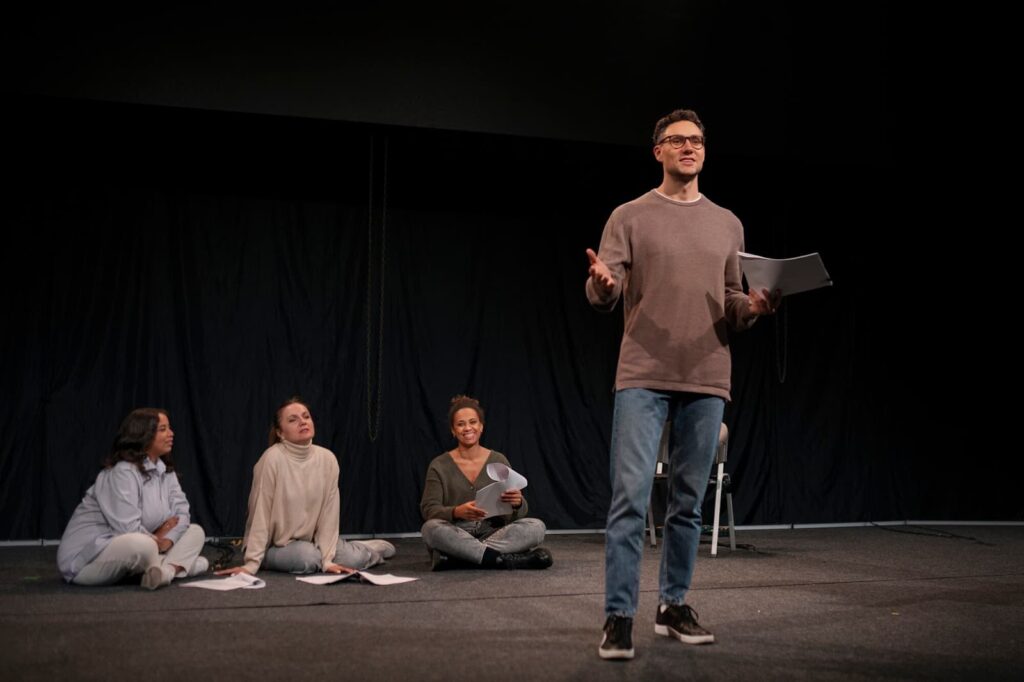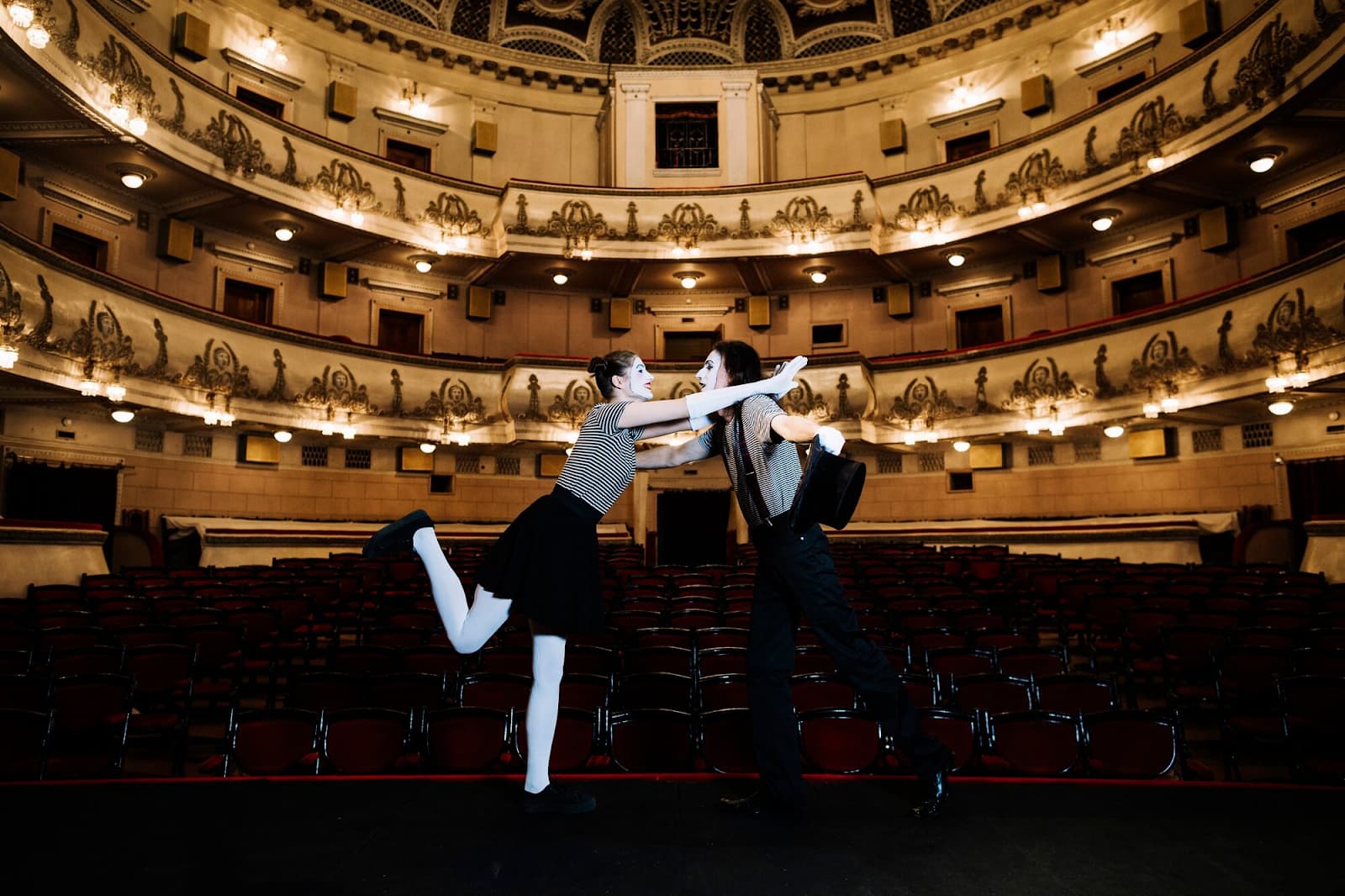As audience members, we often get lost in the magic of a live performance. We marvel at the actors’ performances, the intricate set designs, and the stunning costumes. But there’s another crucial element that goes into creating a successful production – stage blocking.
Stage blocking is the process of planning and choreographing the movements of actors on stage. It involves finding the most effective ways for characters to move, interact, and use the space around them to tell a story. In other words, it’s the art of bringing a show to life.
In this article, we’ll dive into the world of stage blocking. We’ll explore what it is, why it’s essential, and how it’s done. So, let’s get started!
What is Stage Blocking?
Stage blocking is a critical component of theater and performing arts. It’s a collaborative effort between directors, actors, and designers to create a cohesive and visually appealing production. The main goal of stage blocking is to enhance the storytelling and create a dynamic and engaging experience for the audience.
At its core, stage blocking is all about movement. It involves the placement of actors on stage, their entrances and exits, and their physical interactions with props, set pieces, and other actors. It also includes facial expressions, body language, and gestures that convey emotions and relationships between characters.
Why is Stage Blocking Important?
Stage blocking may seem like a minor detail in the grand scheme of putting on a show, but it’s crucial to the success of a production. Here are some reasons why stage blocking is essential:
1. Enhances the Storytelling
Theatre is a visual medium, and stage blocking helps bring the script to life. It provides structure and direction to the narrative and adds depth and dimension to the characters. With strategic blocking, the audience can follow the story more easily and understand the relationships between characters.
2. Adds Visual Interest
A well-blocked show is visually appealing and keeps the audience engaged. It creates a sense of movement and energy on stage, making the performance more dynamic. The right use of space, levels, and composition can make a significant impact on how the audience perceives the show.
3. Ensures Safety
Stage blocking also plays a crucial role in ensuring the safety of actors and crew members. With careful planning, potential hazards can be identified and avoided, preventing accidents and injuries during performances.
4. Sets the Tone and Mood
The way actors move on stage can convey powerful emotions and set the tone for a scene. For example, a slow, deliberate pace may indicate a serious or dramatic moment, while quick, energetic movements could signify excitement or chaos. With proper blocking, directors can control the mood and atmosphere of a show effectively.
The Process of Stage Blocking
Now that we understand what stage blocking is and why it’s important let’s take a closer look at the process of creating effective stage blocking. Here are the five key steps involved:
1. Reading and Analyzing the Script
The first step in stage blocking is to read and analyze the script thoroughly. Directors must have a clear understanding of the story, characters, and their relationships before they can begin the blocking process. They should also consider the overall themes, tone, and mood of the play.
2. Mapping Out the Space
Once the director has a good grasp of the script, they need to map out the stage space. This involves taking measurements, determining the size and dimensions of the stage, and identifying any set pieces or props that will affect the movement of actors. Having this information will help directors visualize the flow of the show and make informed decisions on stage blocking.
3. Collaborating with Designers and Choreographers
Stage blocking is a collaborative process that involves designers and choreographers. Directors should work closely with set, lighting, and costume designers to ensure that their visions align and complement each other. They must also collaborate with choreographers to create fluid and coordinated movements for actors on stage.
4. Rehearsing and Fine-tuning
Once the initial blocking has been established, it’s time to rehearse. During this process, directors can make adjustments and fine-tune the blocking to fit the actors’ performances better. It’s also an opportunity to see how the blocking works in different scenes and make any necessary changes.
5. Refining for the Audience
The final step in the stage blocking process is to refine it for the audience. During dress rehearsals, directors can observe how the blocking looks from the audience’s perspective and make any necessary adjustments. They may also use feedback from test audiences to improve the overall flow and impact of the show.

Techniques and Strategies for Effective Stage Blocking
Now that we understand the process of stage blocking let’s look at some techniques and strategies that directors can use to enhance their blocking:
1. Levels
Creating levels on stage adds visual interest and depth to a scene. It involves placing actors at different heights, such as standing, sitting, or lying down. This technique can be used to convey the power dynamics between characters or add variety to a scene.
2. Symmetry and Asymmetry
Directors can play with symmetry and asymmetry to create balance and tension on stage. Using symmetrical blocking, where actors are evenly placed on both sides of the stage, can create a sense of stability. Asymmetrical blocking, where actors are unevenly placed, can add dynamic energy to a scene.
3. Crosses and Counter-crosses
Crossing refers to an actor moving from one part of the stage to another. This technique can be used to introduce new characters, change the focus of a scene, or create tension between two characters. Counter-crossing occurs when two actors cross each other’s paths on stage, adding visual interest and complexity to their interaction.
4. Focus and Composition
Directors must consider the composition of actors on stage to create visually appealing scenes. They should also use focus to guide the audience’s attention to the most critical elements of a scene. For example, having one character in the foreground and others in the background can convey their relationships and emotions.
5. Use of Props and Set Pieces
Props and set pieces can play an essential role in stage blocking. Directors must consider how actors will interact with these objects and use them to enhance the storytelling. They should also ensure that props and set pieces are placed strategically to facilitate smooth movements and transitions.
Common Mistakes to Avoid in Stage Blocking
Stage blocking may seem straightforward, but it can be challenging to get it right. Here are some common mistakes that directors should avoid when blocking a show:
- Ignoring the Script: Directors must remember that stage blocking is all about serving the story. They should not let their personal preferences or biases override what’s written in the script. It’s essential to stay true to the intentions of the playwright and bring their words to life;
- Not Considering the Actors’ Abilities: Not all actors have the same physical capabilities or training. Directors must consider their actors’ strengths and limitations when creating stage blocking. Asking actors to perform movements that are beyond their abilities can lead to injury and hinder their performances;
- Overcrowding the Stage: Too many actors on stage can create chaos and confusion for the audience. Directors should avoid overcrowding and instead use strategic positioning and movement to guide the audience’s focus. They should also consider the size and dimensions of the stage and ensure that there is enough space for actors to move freely;
- Lack of Variety: Repetitive movements or stagnant blocking can make a show dull and uninteresting. Directors must vary the types of movements, levels, and compositions used in each scene. This will keep the audience engaged and enhance the visual appeal of the performance;
- Not Considering Sightlines: Directors must consider the audience’s perspective when creating stage blocking. It’s essential to ensure that all actors’ faces are visible to the audience at all times. Otherwise, they may miss crucial moments and lose the impact of the story.
Conclusion
Stage blocking is a vital aspect of creating a successful production. It involves careful planning, collaboration, and creativity to bring the script to life and engage the audience. By understanding its importance, following the process, and using effective techniques, directors can create dynamic and visually appealing stage blocking that enhances the storytelling and brings a show to life. So, remember to block, move, and tell your story with confidence and precision!
